
The variable checkerspot or Chalcedon checkerspot is a butterfly in the family Nymphalidae. It is found in western North America, where its range stretches from Alaska in the north to Baja California in the south and extends east through the Rocky Mountains into Colorado, Montana, New Mexico and Wyoming. The butterfly is usually brown or black with extensive white and yellow checkering and some red coloration on the dorsal wing. Adult wingspan is 3.2–5.7 cm (1.3–2.2 in). Adult butterflies feed on nectar from flowers while larvae feed on a variety of plants including snowberry (Symphoricarpos), paintbrush (Castilleja), Buddleja, Diplacus aurantiacus and Scrophularia californica.

Anaea aidea, the tropical leafwing, is a species of brush-footed butterfly in the subfamily Charaxinae. Its native range extends from Mexico to northwestern Costa Rica, with strays sometimes seen in southern Texas, Arizona, and California in the United States. Some authors consider Anaea aidea to be a subspecies of Anaea troglodyta.
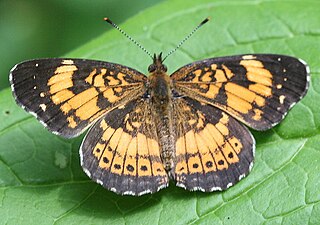
Chlosyne nycteis, the silvery checkerspot, is a species of Nymphalinae butterfly that occurs in North America. It is listed as a species of special concern in Connecticut and Maine, and is believed extirpated in Connecticut, Massachusetts, and New Hampshire.

Edith's checkerspot is a species of butterfly in the family Nymphalidae. It is a resident species of western North America and among the subspecies, entomologists have long been intrigued by their many phenotypic variations in coloration, wing length, and overall body size. Most populations are monophagous and rely on plants including Plantago erecta and Orthocarpus densiflorus as their host species in developing from eggs through to larvae, pupae, and mature butterflies. Males exhibit polygyny whereas females rarely mate more than once. Males devote most of their attention to mate acquisition, and such mate locating strategies such as hilltopping behavior have developed. Climate change and habitat destruction have impacted certain subspecies. Three subspecies in particular, Euphydryas editha quino, Euphydryas editha bayensis and Euphydryas editha taylori, are currently under protection via the Endangered Species Act.

Cecropterus toxeus, also known as the coyote cloudywing or coyote skipper, is a species of butterfly in the family Hesperiidae. It is found from Panama, north through Central America and Mexico to central Texas. Strays can be found up to southern Arizona.

Anthanassa frisia, the Cuban crescentspot, Cuban checkerspot or Cuban crescent, is a butterfly of the family Nymphalidae. Subspecies tulcis is known by the common names pale-banded crescent or Tulcis crescent; it is treated as a species by some authors.

Calpodes ethlius, the Brazilian skipper, larger canna leafroller or canna skipper, is a butterfly of the family Hesperiidae. It is found in the United States from southern Florida and southern Texas, south through the West Indies, Mexico, and Central America to Argentina. Strays and temporary colonies can be found north to southern Nevada, northern Texas, Illinois and Massachusetts.

Chlosyne ehrenbergii, the white-rayed checkerspot, white-rayed patch or Ehrenberg's patch, is a butterfly of the family Nymphalidae. It is found in Mexico.
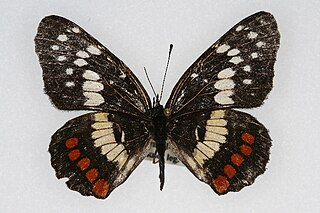
Chlosyne marina, the red-spotted patch or marina checkerspot, is a butterfly of the family Nymphalidae. It is found in Mexico. Rare strays can be found as far north as southern Arizona and southern Texas.

Chlosyne fulvia, the Fulvia checkerspot, is a butterfly of the family Nymphalidae. It is found in North America from Kansas, Colorado, southern Utah and Arizona south to central Mexico.
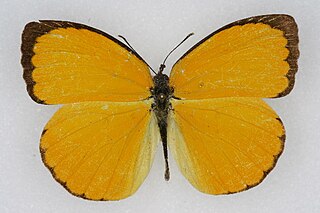
Eurema dina, the dina yellow, is a butterfly in the family Pieridae. The species was first described by Felipe Poey in 1832. It is found from Panama north to southern Florida. The species is regularly recorded from southern Texas and south-eastern Arizona. The habitat consists of forest edges, brushy fields and open forest.
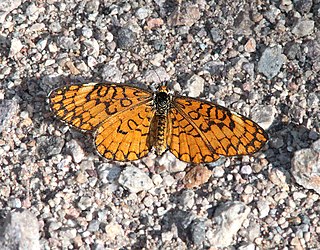
Dymasia is a monotypic genus of butterflies in the family Nymphalidae. Its single species is the tiny checkerspot, also known as the dyman checkerspot, which is found from the southern United States to Central America.
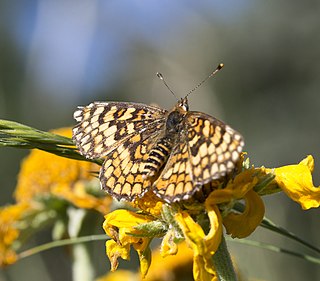
Poladryas is a monotypic genus of butterflies from United States and Central America in the family Nymphalidae. The single species it contains is Poladryas minuta, the dotted checkerspot.

Texola is a genus of butterflies found from southern United States to Mexico in the family Nymphalidae.

Anthanassa texana, the Texan crescentspot, is a species of butterfly in the family Nymphalidae. It is found from Guatemala north through Mexico to southern California, east across the southern United States to northern Florida, Georgia and South Carolina. Strays may be found up to Arkansas, Missouri, Illinois, South Dakota, and central Nevada. The habitat consists of deserts, dry gulches, open areas, streamsides, road edges, and city parks.

Hemiargus ceraunus, the Ceraunus blue, is a species of butterfly in the family Lycaenidae. The species was first described by Johan Christian Fabricius in 1793. It is found in the southwestern United States, southern Texas, Florida and the Florida Keys south through the West Indies, Mexico and Central America to South America. Strays may be found in North Carolina, Missouri, Kansas and Nevada. The habitat consists of open woodland, desert scrub, dunes, pastures, road edges and vacant lots.

Heliopetes laviana, the Laviana white-skipper or Laviana skipper, is a butterfly in the family Hesperiidae. It is found from Argentina through Central America and northern Mexico to southern Texas. Strays can be found in southern Arizona and central and northern Texas. The habitat consists of edges of brushy areas, trails, roadsides, open woodland, thorn forest and streamsides.


















